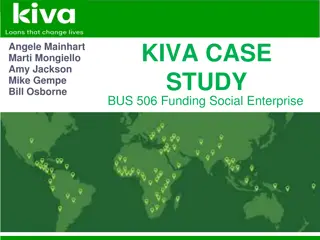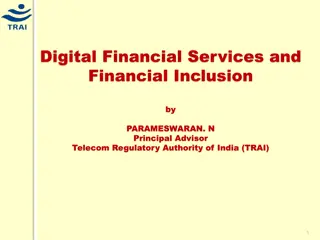Microfinance: Empowering the Poor Through Financial Inclusion
Microfinance has become mainstream, providing financial services such as small loans to empower the poor in developing countries. Through microfinance institutions (MFIs), individuals can access capital, increase income, and decrease vulnerability to unforeseen circumstances. Despite criticisms of high interest rates, microfinance has shown positive impacts, particularly benefiting women entrepreneurs. MFIs face challenges in sustainability and profitability but continue to make a difference in communities worldwide.
Uploaded on Nov 27, 2024 | 0 Views
Download Presentation

Please find below an Image/Link to download the presentation.
The content on the website is provided AS IS for your information and personal use only. It may not be sold, licensed, or shared on other websites without obtaining consent from the author. Download presentation by click this link. If you encounter any issues during the download, it is possible that the publisher has removed the file from their server.
E N D
Presentation Transcript
The Poor Will Be Glad Chapter 7: Microfinance Goes Mainstream Alissa Wachter TUL 560 Community Economics February 2012
Microfinance Goes Mainstream Providing financial services, such as small loans, to poor people so they can increase their income and decrease their vulnerability to unforeseen circumstances. Muhammad Yunus wins Nobel Peace Prize in 2006 Most poor people in developing countries are clinging to the edge of a cliff Small loans permanently improve conditions by allowing people to: buy in bulk, travel less, offer additional services, buy equipment, reduce labor costs, increase output
About the Loans MFI s (Microfinance Institutions) provide capital from donors or commercial lenders Size: Generally 1/4-1/3 of country s annual income Terms: 6 months, paid weekly Maximized impact: Funds recycled to other borrowers Repayment: 95-98% repayment Collateral: social guarantee and incentive
What are the Interest Rates? Primary criticism of microfinance Average annual rate: 30-50% with (including fees and inflation) Reasons for interest: MFI s self-sufficiency Inflation Most include training or health/emergency insurance
Women & Responsible Credit 80% worldwide go to women: More likely to have a small business More likely to repay More likely to impact whole family Less likely to be involved in income- negative activities MFI s provide training in responsible use of credit Increasing income, not paying off other debt
Trends and Events Donors: Difficult to secure long-term; fundraising requires time & money Profits: MFI s can make a profit; sometimes means higher interest or reduced services Commercial services: MFI s can borrow money from outside sources (i.e. banks); easier to access than donor $ but can mean higher interest or decreased services
Does Microfinance Work? MFI s can be easily replicated As size increases, so do overhead costs reduce Emerging research and anecdotal evidence shows impact on communities Seeing it in action is the best way to understand impact























